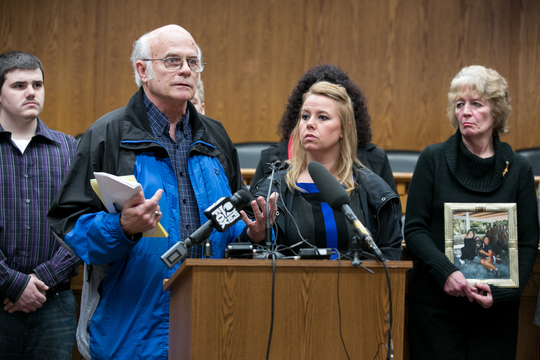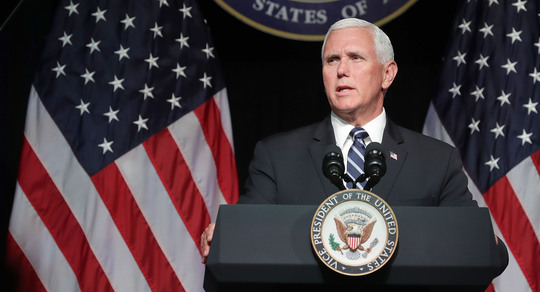|
Report from Olympia | October 16, 2018
 At a 2014 news conference at the Capitol, responding to the governor’s announcement that he was placing a moratorium on capital punishment, the families of victims whose killers were on death row made it clear that the death penalty provided them with a sense of closure.
Dear
Friends and Neighbors,
Last week, I traveled
to the “other Washington” to participate in a conference and briefing at the
White House. It was a great experience that allowed me to hear directly from
high-ranking Administration officials, while also sharing with them the concerns
and views of our district.
While I was away,
however, news of another major court decision broke. Washington’s state Supreme
Court ruled 9-0 on Thursday that the practical application of the death penalty
in our state is unconstitutional. You can read more about this decision, what
it means for our state, and coverage of my comments on the topic in this issue
of Report from Olympia.
If you have any
questions about any of the issues discussed in this newsletter, please feel
free to contact my office. I am here to be your voice in Olympia, and hearing
directly from you is one of the best ways for me to accomplish that goal.
Thanks again for the
honor of representing you in the Washington State Senate.
Sincerely,

Senator
Mike Padden

Surprise
appearances made by Vice President Pence and Kellyanne Conway
 Vice President Mike Pence met with local Northwest elected officials.
On Thursday, Oct. 11, I had the honor and privilege of representing our
state at a “White House Conference with Washington State and Local Leaders” for
remarks and discussions with key administration officials and policymakers on
issues affecting the states of Washington and Oregon.
So many issues that affect our citizens – from transportation to forest
management – are either decided or influenced by the federal government. It is
critical that we be able to work effectively with federal officials and know
who to turn to when we have questions or need assistance for our constituents.
I was invited to the conference by the White House Office of
Intergovernmental Affairs, which serves as the primary liaison between the
White House and state, county, local, and tribal governments. Presenters
included:
- Douglas
Hoelscher, Deputy Assistant to the President and Director of White House
Intergovernmental Affairs;
- Frank
Brogan, Assistant Secretary of Elementary and Secondary Education, U.S.
Department of Education;
- Anthony
Bedell, Deputy Assistant Secretary, U.S. Department of Transportation;
- Paul
Lawrence, Undersecretary for Benefits, U.S. Department of Veterans
Affairs; and
- Secretary
Ryan Zinke, U.S. Department of Interior.
I was especially interested in Secretary Zinke’s discussion of wildfire
management, considering it hadn’t even been three months since the Upriver
Beacon Fire in Spokane County caused the evacuation of nearly 800 homes and
evacuation warnings for thousands more.
Zinke, a former Montana congressman who is familiar with the wildfire
situation in the Northwest, believes years of failure to effectively tend our
forests means more dead logs and other “fuels” that cause hotter, more intense
wildfires. He supports reducing the fuel load through prescribed burns,
mechanical thinning and timber harvests – actions our Legislature has endorsed
at the state level in the past two years.
According to the Secretary, his agency and the U.S. Department of
Agriculture have secured bipartisan support for maintaining forests in ways
that ease the recurrence and severity of wildfires. He has also signed an order
mandating aggressive fuel management and increasing the use of drones to
monitor and contain fires.
In addition to fire management, the secretary also discussed plans to plant
early-detection beacons in our national parks as an early-warning system for
earthquakes.
VA Undersecretary Lawrence announced that the agency soon will launch an
initiative to modern electronic medical records. Launching events will be in
Spokane, Seattle and American Lake (near Joint Base Lewis McChord).
A couple of surprise visitors interrupted the schedule. Vice President Mike Pence stopped by to let the state and local
officials know he supports turning over more federal responsibilities to
state and local officials. He indicated the Trump-Pence administration
was a 10th Amendment friendly administration.
Then White House counselor
Kellyanne Conway joined us to discuss the opioid crisis, which the
president declared a national emergency nearly a year ago. It was heartbreaking to hear the numbers –
nearly 175 Americans die each day from opioid abuse, with a projected economic
burden of nearly $500 billion annually – but Conway told us the steps the
Administration is taking to stop illegal drugs at the border, increase
prevention education and provide additional resources for treatment are all
starting to bear fruit.
The National Survey on Drug Use and Health reports that in 2017, about 11.4
million people misused opioids – down from 12.7 million people in 2016. About
56 percent of people sought treatment for their addiction in 2017, up from 37
percent in 2016. While the numbers are moving in an encouraging direction, they
are still way too high, and there is still much work to be done.
Overall, the trip was not only informative, but it was also a great
opportunity to make contacts within the administration who may be helpful
in the future.

In the News:
CNBC | Sept. 20, 2018

The number of Americans filing for
unemployment benefits unexpectedly fell, hitting near a 49-year low in a sign
the job market remains strong.
Initial claims for state unemployment
benefits fell by 3,000 to a seasonally adjusted level of 201,000 for the week
ended Sept. 15, the Labor Department said. That is the lowest level since
November 1969. Data for the prior week's claims was unrevised.
Economists polled by Reuters had forecast
claims rising to 210,000 in the latest week.
The Labor Department said only claims for
Hawaii were estimated. The four-week moving average of initial claims,
considered a better measure of labor market trends as it irons out week-to-week
volatility, declined by 2,250 to 205,750 last week, the lowest level since
December 1969.
Click
here to view the whole story.
|

 Sherry Shaver, left, holds a photo of her two daughters, Venus, left, and Telisha, right, as she stands with her husband Roger Shaver, right, Wednesday, Feb. 26, 2014, during a news conference at the Capitol in Olympia, Wash. (Ted S. Warren/ AP Photo)
On Thursday morning, the state Supreme Court unanimously
overturned the death penalty as it is currently administered.
The decision stemmed from an appeal of the death
sentence for Allen Eugene Gregory. His victim was raped, robbed, and stabbed
repeatedly before her neck was slashed. Gregory was convicted of three counts
of rape in addition to murder.
The court reviewed Gregory’s claim that the
death penalty disproportionately affects African-Americans. In reaching its
decision, the justices relied upon a study commissioned by the University of
Washington that concluded that counties with higher black populations pursue the
death penalty more and black defendants are 4½ times more likely to be
sentenced to death than white defendants.
Based on this, the court found Washington's
death penalty is administered in an arbitrary and racially biased manner, and
struck it down as a violation of article I, section 14 of the state
constitution.
Frustratingly, the justices acknowledged several
errors and subjectivity in the UW study, but stated that they “decline to
require indisputably true social science to prove that our death penalty is
impermissibly imposed based on race.”
The court noted it was not declaring Washington’s
method of execution to be unconstitutional and stated “[w]e leave open the
possibility that the legislature may enact a "carefully drafted statute to
impose capital punishment in this state, but it cannot create a system that
offends constitutional rights.” Unfortunately, the court did not leave many
clues as to how the Legislature could accomplish that.
I am disappointed with this ruling. It set an
unnecessarily high burden. Circumstances will never be equal in a state where prosecutors
in 39 counties have discretion whether to seek the death penalty for individual
cases.
While I believe the death penalty should be used
rarely, the heinous offenses committed by those on our state’s death row are
evidence that capital punishment is still the best fit for some crimes. The
death penalty is also a helpful tool for prosecutors to use when trying to
reach a plea agreement or get a defendant to disclose the location of a victim’s
body.
This decision is also likely to cause more pain
to the family of victims. Sherry Shaver thought she had found closure in 1997
when a jury recommended the death penalty for the man who killed her daughter
in Spokane Valley. Even after the governor issued a moratorium on the death
penalty in 2014, she held out hope that a new governor might reinstate the
death penalty for her daughter’s killer.
Though her daughter’s murderer died last year of
a heart attack, she still sees the death penalty as instrument of justice for
other victims and is devastated by the court’s ruling.
You
can click the links below to read additional coverage of this decision,
including my thoughts on how we move forward.

In the News:
Staff Report, Spokane Journal of Business | Oct. 11, 2018
 Conceptual art
Central Valley School District has released a
first look at the conceptual design of its planned new $95 million high school,
which is slated to be constructed along East Country Vista Drive. ALSC
Architects PS, of Spokane, is expected to complete design work next spring. A
general contractor hasn’t been selected yet for the project, but work is
scheduled to start in mid-2019. The new facility, which will be the third high
school in the district, is slated to open in time for the 2021-22 school year.
You can read the full article by clicking
here.
* * *
|